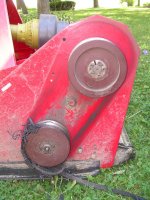IslandTractor
Super Star Member
- Joined
- Sep 15, 2005
- Messages
- 17,101
- Location
- Prudence Island, RI
- Tractor
- 2007 Kioti DK40se HST, Woods BH
I did some more mowing with the solid tensioner set up on the TM1900 today. Ambient temp about 80. I set the cruise control to run the tractor a bit slower than I was driving last week so I did not bog down at all. Temps made exactly as I described in the earlier post. Measured after about 2 hours of mowing (first in a lighter field then in the field that I was bogging down in last week).
Cover: 155F
Top pulley central 206
Top pulley near belts 215
Bottom pulley 206
Gearbox 130
Bearing on non drive side 88
Belts on top pulley 200 (measured last...and top pulley was about 200 at that time too....temps drop quickly initially.)
It looks like when I mowed at a speed that did not bog the engine I got pretty much the same temp readings as I had with the spring tensioner. Again, my conclusion is that there does not appear to be any significant difference between spring and solid tensioner.
Cover: 155F
Top pulley central 206
Top pulley near belts 215
Bottom pulley 206
Gearbox 130
Bearing on non drive side 88
Belts on top pulley 200 (measured last...and top pulley was about 200 at that time too....temps drop quickly initially.)
It looks like when I mowed at a speed that did not bog the engine I got pretty much the same temp readings as I had with the spring tensioner. Again, my conclusion is that there does not appear to be any significant difference between spring and solid tensioner.

